|
Posted on 01/15/2004 12:01:10 AM PST by SAMWolf
|
|
 are acknowledged, affirmed and commemorated.
|

| Our Mission: The FReeper Foxhole is dedicated to Veterans of our Nation's military forces and to others who are affected in their relationships with Veterans. In the FReeper Foxhole, Veterans or their family members should feel free to address their specific circumstances or whatever issues concern them in an atmosphere of peace, understanding, brotherhood and support. The FReeper Foxhole hopes to share with it's readers an open forum where we can learn about and discuss military history, military news and other topics of concern or interest to our readers be they Veteran's, Current Duty or anyone interested in what we have to offer. If the Foxhole makes someone appreciate, even a little, what others have sacrificed for us, then it has accomplished one of it's missions. We hope the Foxhole in some small way helps us to remember and honor those who came before us.
|
|
in Kentucky, Indiana, and Ohio (July 1863) One of the most interesting phases of the Civil War was the well-known raid conducted by General John Hunt Morgan through Kentucky, Ohio and Indiana in the summer of 1863. This daringly executed foray deep into enemy territory was strictly a nuisance, and little more, for it did not help the Southern cause to any significance. However, the few days the raid lasted it caused a great deal of excitement and considerable inconvenience to the people of Southern Indiana.  Morgan's Raid, July 2-16, 1863 Local interest in this spectacular raid lies in the fact that Morgan and his men traversed Scott County from west to east over the route of the old historic Cincinnati Trace (then called the Lexington-Salem State Road), and that he and his men spent one of the four nights they camped in Indiana in Lexington, then the county seat of Scott County. Further interest is derived from the fact that General Morgan and the Morgan family of Scott County are related. One of Scott County's pioneers, David Morgan -- father of Nathan R. Morgan, came to the county in 1820 from Bourbon County, Kentucky. Although the exact relationship between the two families has not as yet been established, David Morgan was probably a first cousin of Calvin C. Morgan, father of John Hunt Morgan, and both were grandsons of Gideon Morgan (died 1830) who emigrated from New Jersey to Virginia sometime before the Revolutionary War and who was a kinsman of General Daniel Morgan (1736-1802) of Revolutionary War fame. It is said that when General Morgan and his Raiders came through Scott County he sent word to his Indiana kinfolks that he wished to visit them while in the County, but was prevented from doing so by the exigencies of war!  General John Hunt Morgan, CSA John Hunt Morgan, son of Calvin and Henrietta Hunt, was born June 1, 1825 in Huntsville, Alabama from whence his father and his grandfather, Luther Morgan, had emigrated from Virginia. When he was three years old, his father moved to his mother's home town of Lexington, Kentucky where he grew up. In the war against Mexico he served as a First Lieutenant in a cavalry regiment. Following this, he engaged in manufacturing in Lexington, Kentucky and became quite wealthy. His home can still be seen there. At the outbreak of the Civil War in 1861 he and his four brothers--Calvin, Charlton, Richard and Thomas, joined the Confederate Army. His two sisters were married to Confederate generals--Ditty to General A. P. Hill and Henrietta to General Basil W. Duke, who accompanied his brother-in-law on his famous raid and later wrote his authoritative History of Morgan's Cavalry. In 1862, following the Battle of Shiloh, John Hunt Morgan was made a Colonel and still later a General.  MATTIE READY and JOHN HUNT MORGAN Shortly before Christmas of 1862 Morgan, 37, married Mattie Ready, 17, in Murfreesboro, TN. Several days after the wedding Morgan and his cavalry set out on a raid north of the Cumberland River. Wilder and his men were sent in persuit--on foot! Both brigades would miss each other, and the battle of Stones River. His men, collectively and in detached bands, became famous for partisan warfare throughout Kentucky and Tennessee, raiding towns, robbing trains, destroying railroad property and committing deeds of violence amounting to highway robbery, except so far as excused by the state of war. Morgan's famous raid through Kentucky, Indiana and Ohio was probably done with the deliberate intent of creating a diversion from the movement of General Braxton Bragg and his troops from Tullahoma to Chattanooga, Tennessee. However, Morgan disobeyed Bragg's (1817-1876) instructions to confine himself to Kentucky and started on a forlorn trip which was doomed to failure. On May 26, 1863 Morgan had 2460 men, two three-inch Parrott guns and two twelve-inch howitzers. Two brigades under him were principally composed of men from the Second, Third, Fifth, Sixth and Eleventh Kentucky and the Ninth Tennessee Cavalry Regiments. They were commanded by General Basil W Duke and Bushrod Johnson.  Parrott gun On June 11, 1863 they left their headquarters at Alexandria, Tennessee and on July 2 crossed the Cumberland River at Burkesville, Kentucky. In a battle at Columbus, Kentucky on July 4th, they lost sixty men when they unexpectedly encountered Federal troops. On July 5th they fought and captured the Federal garrison at Lebanon, Kentucky. It was during this battle that General Morgan's youngest brother, Lieutenant Thomas Morgan, was killed. On Tuesday, July 7th, Morgan's advance guard reached Brandenburg, Kentucky on the Ohio River forty miles below Louisville. On July 8th his men captured the steamers "J. T. McCombs" and "Alice Dean" and were successfully ferried across the river to the Indiana shore. Then they proceeded to loot the town of Mauckport, two miles down the river from their crossing. From Mauckport the Confederate cavalry drove into Corydon where stores were raided, the county treasury robbed, private homes pillaged and women forced to prepare meals for the unwelcome guests. General Morgan made his headquarters at the town's main hotel, Kintner's. Meanwhile, over 500 horses were taken from their owners in the nearby countryside in exchange for poor, worn-out ones.  The same day, July 9th, Federal troops under General Edward Hobson reached Brandenburg, crossed the river, and subsequently pursued Morgan's Raiders across the entire states of Indiana and Ohio. The Confederates spent the night in Corydon and the morning of July 10th, leaving eleven wounded soldiers to be cared for by the citizens of the town, they advanced on Salem in two columns. Morgan delayed a few hours in Palmyra while one column of his troops looted Paoli and another Greenville, in Floyd County. After dispersing the Home Guard at Salem they occupied and thoroughly plundered the town. Men were seen, it has been said, riding around carrying all sorts of booty. One cavalryman had a bird cage with three canaries in it, and others had bolts of calico tied to their saddles. However, no examples of personal violence or cruelty were reported. Leaving Salem in two columns they headed for Lexington. One column crossed the Jeffersonville and Indianapolis Railroad at Henryville, Clark County, while the other went by way of Canton, New Philadelphia and Leota and, at approximately six o'clock, they arrived at the same railroad in Vienna.  From Harper's New Monthly Magazine (August, 1865), Courtesy of Burton Milward At Vienna the railroad station and the telegraph operator were captured before the operator could give the alarm. General Morgan put one of his own men, Lieutenant Ellsworth who knew how to operate the telegraph, in charge of the office. He listened on the wires until he had learned all the news to be obtained from Louisville and Indianapolis, including the fact that orders had been issued to the Militia to fell timber and blockade the principal roads which the invaders would be likely to travel to the East. According to Duke "our rapid marching had, hitherto, saved us this annoyance." They also learned in this manner that the Union forces under Hobson had crossed the Ohio River and were only a few miles behind them. They learned that the state was virtually swarming with soldiers and that every train entering Indiana was bringing additional forces. The Raiders did all they possibly could to hamper the pursuit of the Union Cavalry, such as burning all the bridges. Their system of horse stealing was almost perfect. They would dispatch men from the head of each brigade to go five miles into the country on each side of the road. They would then seize every available horse and fall in at the rear of the column. In this way the Confederates swept the countryside of all horses for ten miles, leaving their own worn-out animals for the use of the Union forces.  According to Goodrich in his Illustrated History of Indiana (1875), a Scott County farmer ruefully said, "Many are the farmers through this county who have bewailed the day when they 'swapped' their fine, fat, sleek horses for the worn-out, sore-backed jades of the Rebels!" The fine blooded Kentucky horses, however, which were left behind in Indiana, though worn-out, were of such good stock that the breed of Indiana horses was greatly improved. At both Henryville and Vienna the railroad depots were burned, the tracks torn up and the telegraph wires cut. At Vienna they also burnt the water station, the turntable and a railroad bridge which spanned Pigeon Roost Creek. All of these structures were built of wood, as was the custom then. In Vienna they also robbed the stores and private houses.
|
LOL! Good one.
CSMC, by SHIP's DETACHMENT,PLATOON & COMPANY,
MEMORIAL SALUTE!
LOAD BLANKS, reloading at will.
THREE volleys, at my command.
FRONT ranks KNEEL!
READY,
AIM,
FIRE!
free dixie,sw
free dixie,sw
|
Air Power |
In 1965 Nikita Khrushchev, who did not think highly of air forces and who stopped many developing aviation programmes, left active political life. Also, in 1965, the United States formulated specification for a new Advanced Manned Strategic Aircraft (AMSA), which would be the B-1. This together with the already ongoing development of the XB-70 Valkyrie bombers, inspired the Soviet government to specify requirement for a strategic bomber. On 28 November 1967 the competition for the new strategic bomber began. Technical parameters were high. The aircraft was to reach 11000 to 13000 km (5,970 to 7,020 nm) and have a cruising speed of 3200 to 3500 km/h. The maximum range at subsonic speed was to be 16000 to 18000 km (8,640 to 9,720 nm) at high altitude. Basic armament was to be nuclear missiles, including heavy Kh-45 and small Kh-2000s.
Sukhoi came with a variable-geometry winged version of the T-4, named T-4M. Due to the arrangement of the engines, the weapons would have to be carried externally. Sukhoi abondoned the design and started a new program, named T-4MS, although it had nothing in common with the original T-4. The T-4MS would be capable of meeting the demands and carry two Kh-45 missiles inside a bomb bay, as well as two Kh-45 externally.
Myasishchev's Design Bureau disbanded when it stopped work on the M-50 'Bounder' design in 1960. In October 1966 it was reinstated under the name of EMZ - Experimentalnyi Maschinostroitelnyi Zavod (Experimental Engineering Plant). Myasishchev worked on four different designs under designation M-20 in 1967-1968.
Tupolev, which was formally called Moscow Engineering Plant 'Opyt' (meaning Test), joined Sukhoi and Myasishchev in the quest for a supersonic strategic bomber. Tupolev's design team had the best chance, because of the bureau's experience with bomber aircraft dating back to the 1930s. Unlike the others, Tupolev started designing by not aiming at the specifications given by the government. Tupolev thought a Mach 3.0 to 3.2 bomber, compared with a Mach 2.3, did not off-set the cost of construction and technology. In the early 1970s Tupolev prepared a series of flying-wing designs designated 160M, which were based on the contemporary delta-winged Tu-144 supersonic airliner.
In 1972 the air forces selected Sukhoi as the winner, however it was realised a design with these specifications was not possible. So it was decided to start a second stage of the competition. The maximum speed was lowered to Mach 2.3 enabling Tupolev's 160M flying-wing design to enter the competition. Myasishchev came with the M-18, based on the M-20 design which had a variable-geometry wing. Sukhoi gave up the competition and decided to concentrate on fighter aircraft.
The air force selected the M-18, because of its variable-geometry wing design and the design was supported by TsAGI (large and powerful Soviet technical research institute) and the Technological-Scientific Council of the Ministry of Air Industry. Tupolev's flying-wing design was a single-mode aircraft and the air force required bomber following a compound flight profile and be able to also land at 'smaller' airfield.
Myasishchev's winning design was developed by the Tupolev bureau, because the former's team was too small. In 1973 the first design for the Tu-160 was prepared by Tupolev based on the M-18 variable-geometry design. The design was gradually improved and Tupolev began selecting the aircraft systems, together with the scientific and government research institutes. The NK-25 engine of the Tu-22M3 were selected at first, but the high fuel consume rate required a new development. In 1980 the first Nk-32 was testflown on a Tu-142 and production began in 1983.
Aleksei Tupolev (son of Andrei Tupolev, founder of the design bureau) lead the Tu-160 design program during the initial period, in 1975 Valentin Bliznyuk was appointed as chief designer and remains in charge of the program today. In 1977 the preliminary design and a full scale mock up were submitted for state committee acceptance. At this stage the aircraft would carry two Kh-45 missiles. During the Strategic Arms Limitation Treaty II (SALT II) talks in the late 1970s, the plans for a new strategic bomber and the name Tu-160 were first revealed to the west.
When the Soviets learned about the American AGM-86 ALCM-B cruise missile, the requirement of the Kh-45 as main armament for the Tu-160 was dropped and a strategic (nuclear) version of the Kh-55 cruise missile was developed. The Tu-160 armament would now consist of 12 Kh-55SM missiles, with 12 to 24 Kh-15 being the alternative. Although there was enough time to design the weapon bays after the plans for Kh-45 were dropped, the Tu-160 design held its long weapon bays. The Kh-55SM and Kh-15 are much shorter, and can be launched with only the forward longer doors openened (each weapon bay has four doors). One reason may be the possibility of the Meteorit-A missiles to be carried by the Tu-160, but these missiles did not pass their test.
Initially a traditional self-defence system was proposed for the Tu-160, including a tail turret with a 30mm GSg-6-30 cannon. However the designer replaced the plans later during developed with the Baykal system. Also the plans for R-77 medium-range air-to-air missiles were abondoned.
The program was accepted in 1977 and Tupolev began production of three prototypes. Although the aircraft were assembled at Tupolev's workshop at Moscow, the sub-assemblies were built at other production plants. However the first prototype 70-01 intended for flight testing the basic flight characteristics had incomplete equipment. Prototype 70-02 was built for static tests. Prototype 70-03 was practically an equivalent of series production aircraft. 70-01 was completed at Zhukovskity in January 1981. On 14 November, the aircraft taxied the airstrip for the first time, after months of testing. On 25 November 1981 a picture was taken of the aircraft near two Tu-144 by a landing passenger at a nearby airfield, this was the first picture of the Tu-160 revealed to the world.
On Friday 18 December 1981 Tu-160 70-01 made its maiden flight. Three months later the first supersonic flight was achieved. And during one of the test flight the top speed of 2200 km/h was reached. The 70-01 can be distinguished from the other Tu-160 by having a long probe at the nose tip. Internally there are greater differences in equipment and structural elements. Work on new materials and engineering methods, lead to postponement of the 70-03 prototype, which did not take off until 6 October 1984.
Series production was started at Ulyanovsk production plant, but was soon replaced to KAPO (Kazan Aviation Production Association) in favor of the An-124 production. The first series Tu-160 took off from Kazan on 10 October 1984. The first aircraft to enter service took off from Kazan on 15 August 1986.
On 23 April 1987 this aircraft as well as a second example were delivered to the 184th Heavy Bomber Regiment of Guards, based at Pryluky airfield in the Ukaine. The squadron had previously been operating the Tu-16 Badger, so it obtained a small number of Tu-22M3 'Backfire-C' to train the crew on high supersonic bombers, with a variable-geometry wing. Later the Tu-134UBL dedicated trainer for the Tu-160 replaced the Tu-22Ms. At the end of 1991, the 184th regiment had two squadron and a total of 19 Tu-160 were delivered.
The first time the Tu-160 was shown to the public was on 20 August 1989 flying over Tushino airfield in Moscow. The first ground presentation was in August 1992 at MosAeroshow held at Zhukovskiy. It made its international debut at the Paris Airshow in June 1995, were it was presented as space carrier for the Burlak space vehicle with a mock up of the Burlak under its belly.
After the break up of the Soviet Union the Ukainian parliament took all military units based in its country under control. At first this had no effect on the 184th bomber regiments. But in 1992 25% of the pilots and personnel swore oath to the Ukraine. At Engels airbase in Russia, the first Russian Tu-160 regiment was formed. Russia had just three Tu-160 remaining at the Kazan factory. On 16 February the first arrived at Engels AB, but because of lack of pilots it was not until 29 July 1992 when the first Tu-160 took off from Engels. The production at Kazan continued for a short while until the air force ran out of money and in June 1994 the sixth and last Tu-160 left the factory for Engels. Four unfinished airframes remained at Kazan.
The Ukrainian 19 Tu-160 from the 184th regiment were flown only a small number of sorties, before they were grounded because of lack of technical support from Tupolev and manufacturer, lack of spares and lack of fuel. Also the Ukraine did not have areas suitable for training with strategic missiles. The Ukraine could not sustain the aircraft and had no need for them, so they started negotiations with Russia in 1991. When in 1998 no agreement was reached, Ukraine decided to scrap the aircraft. The first Tu-160 was cut up in November 1998.
In April 1999, Russia proposed buying back eight Tu-160 and three Tu-95MS 'Bears' which were in the best technical condition, as well as 575 Kh-55 and Kh-55SM missiles, documentation and ground equipment. On 6 October 1999 an agreement was signed and a total of US$285 million was deducted from the Ukraine's outstanding payments to Russia for the supply of natural gas. On 5 November the first two bombers, a Tu-160 and a Tu-95MS, landed at Engels AB. The last two Tu-160 'Blackjacks' arrived at Engels on 21 February 2000. All the aircraft were overhauled at the Kazan factory during 2001. On 5 May 2000, another aircraft that was nearly finished aircraft was commissioned into service at Engels as '07'.
The 182nd Heavy Bomber Regiment of Guards operated 15 Tu-160 'Blackjacks' after all eight Ukrainian Tu-160 were returned into service. In September 2003 one Tu-160 bomber was lost in a fatal crash. Reportedly production restarted work on another one of the unfinished Tu-160 airframes at Kazan to replace the lost bomber. This is the second Tu-160 bomber to be lost in a crash, in 1987 the first Tu-160 (a series production test aircraft) crashed due to an engine problem.
The total number of Tu-160 Blackjacks built was 35 at the end of 2000, comprising of 3 prototypes built in Moscow and 32 series aircraft built in Kazan. Three unfinished aircraft remain at the Kazan factory today. Of the 11 Tu-160 airframes that remained in the Ukraine 1 serves as a gate monument, while the remaining 10 were cut up. The last Ukrainian Tu-160 was cut up in 2001.
Specifications:
Function: long-range strategic penetration bomber and missile platform
Contractor: Tupolev
Crew: 4
Powerplant: four 25,000-kg (55,115 lb) afterburning thrust Kuznetsov NK-321 turbofans
Production today:
Prototype aircraft 3
Development/Test Russia 6
1987-1991 Delivered Pryluky, Ukraine 19
1991-2000 Delivered Engels, Russia 7
(Remaining at Kazan factory) (3)
Total Aircraft Built 35(+3)
Airworthy today:
Prototype 1
Development/Test Russia 3
1987-1991 Delivered Pryluky, Ukraine 8
1991-2000 Delivered Engels, Russia 6
Total Aircraft Airworthy 18
Dimensions:
Length: 177 ft 6 in (54.10 m)
Wingspan: 182 ft 9 in (55.70 m)
Height: 43 ft 0 in (13.10 m)
Weights: Empty: 260,140 lb (118,000 kg) / Maximum Takeoff: 606,261 lb (275,000 kg)
Performance :
Speed: 1,243 mph (1,079 kt)
Ceiling: 52,500 ft (16.000m)
Range: 8,699 miles (14,000 km)
Armaments:
provision for 16500 kg (36.376 Ib) of disposable stores carried in two lower-fuselage weapon bays and on hardpoints under the wing gloves; typical weapons are free-fall nuclear and/or HE bombs, and/or missiles including up to 12 RK-55 (AS-15 'Kent') cruise missiles or 24 RKV-500B (AS-16 'Kickback') short-range attack missiles.
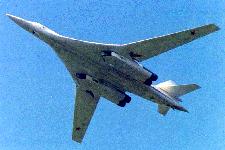
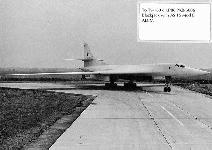
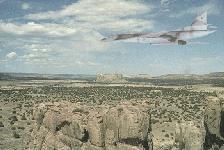
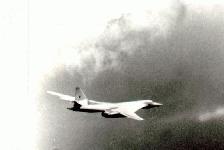


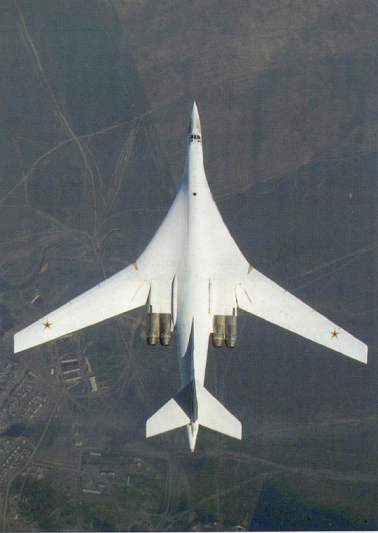

Disclaimer: Opinions posted on Free Republic are those of the individual posters and do not necessarily represent the opinion of Free Republic or its management. All materials posted herein are protected by copyright law and the exemption for fair use of copyrighted works.